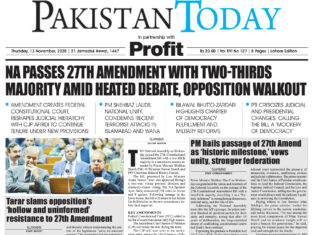‘Welcome to the “polycrisis” — a world in which, as historian Adam Tooze says, “economic and non-economic shocks” are entangled “all the way down”. We have an inflation shock that emanates from the disruptions caused by a pandemic, the policy responses to that pandemic and an energy shock caused by a war. That war in turn is related to the breakdown in relations among great powers. Slow growth, rising inequality and over-reliance on credit have undermined political stability in many high-income democracies. The credit boom led to a great financial crisis whose outcome included a decade of ultra-low interest rates and so even more financial fragility worldwide. Adding to these stresses is the threat of climate change.’ – An excerpt from a recent Financial Times (FT) published article ‘How to think about policy in a polycrisis’
The world currently is the grip of many serious challenges, mainly in the shape of the fast-unfolding existential threat of climate change crisis, high inflation, low growth, rising poverty and inequality, high level of debt at the back of years of cheap money, not to mention overly-tight monetary policy contributing to significant capital flight from developing countries, and in turn, not only strengthening the US dollar and adding to imported inflation, but also raising interest payments.
A higher interest rate and a stronger dollar have not only brought balance of payments worries to many developing countries, but have also sparked default in a number of countries, for instance, Sri Lanka, while creating serious debt servicing worries for many developing countries, like Pakistan; where Pakistan has also been facing one of the worst climate disasters, in the shape of catastrophic floods, which not only affected more than three million people, but has caused serious damage, estimated at around $30 billion.
The world is indeed in a ‘polycrisis’ as for instance renowned economist, Adam Tooze pointed out in this regard in a recent article ‘Welcome to the world of the polycrisis’ published by The Financial Times (FT) as follows ‘Pandemic, drought, floods, mega storms and wildfires, threats of a third world war — how rapidly we have become inured to the list of shocks. …As former US Treasury secretary Lawrence Summers recently remarked: “This is the most complex, disparate and cross-cutting set of challenges that I can remember in the 40 years that I have been paying attention to such things.”’
Here, it needs to be pointed out that while many of the challenges – from climate disasters, to the pandemic, to supply chain crisis, to inflation and low growth – all have a strong imprint of climate change crisis. The recently concluded COP27 meeting in Egypt, \took a step forward in reaching a consensus on forming a loss and damage fund to provide financial reparations to climate-change-affected countries like Pakistan, yet the main source of climate change crisis in the shape of global warming was not properly dealt with. In fact, COP27 meetings overall backtracked on the commitments of last year’s COP26 meetings in Glasgow, with regard to cutting greenhouse gas emissions in a way that global average temperature could be curtailed below 1.5°C. That needs to reverse as soon as possible, so that the world returns to being on track to reach that goal.
This will, in turn, lessen the debt repayment burden, and help reduce capital flight, and imported inflation component; not to mention lower interest rates will also help create more fiscal space in countries, to in turn follow much more freely a non-austerity policy, and in turn, make needed climate, and health-related public and private investments, in addition to overall providing greater social safety protections to vulnerable sections of the society.
The challenge of high debt has also become a serious issue, putting a number of developing countries at risk of default. For this, it is important to move away from the policy of austerity, and instead of pursuing a pro-cyclical policy stance, it is important to move towards a counter-cyclical policy. An important manifestation of this counter-cyclical policy is to revert from an overly tight monetary policy stance, since inflation globally has a significant supply-side emphasis.
This will, in turn, lessen the debt repayment burden, and help reduce capital flight, and imported inflation component; not to mention lower interest rates will also help create more fiscal space in countries, to in turn follow much more freely a non-austerity policy, and in turn, make needed climate, and health-related public and private investments, in addition to overall providing greater social safety protections to vulnerable sections of the society.
Here, a fresh allocation of special drawing rights (SDRs) by International Monetary Fund (IMF) to the tune of $650 billion as August last year, will also help in the non-austerity effort, and will be useful in meaningfully safeguarding against balance of payments crisis, reducing debt default risks, and in reducing the imported inflation component.
The seriousness of the difficult debt situation could be gauged, for instance, from a recent Bloomberg published article ‘Global debt costs are soaring. Here’s where it will hurt most’ as ‘The world is emerging from the cheap-money era with a mountain of debt that’s now getting painfully expensive. All around the globe, there are borrowers deeper in the red than ever before. The total owed by households, businesses and governments stands at $290 trillion, up by more than one-third from a decade ago, according to research by the Institute of International Finance. Although the world’s debt has declined from a pandemic-driven record early this year, the risks it poses to economies and financial markets are intensifying. That’s because many borrowers face a relentless increase in their interest payments, as the Federal Reserve and other central banks raise rates at the fastest pace in decades to subdue inflation.’
Moreover, with regard to the serious severity of the overall crisis situation that the world finds itself in, a recent Project Syndicate (PS) published article ‘The unavoidable crash’ pointed out ‘The world economy is lurching toward an unprecedented confluence of economic, financial, and debt crises, following the explosion of deficits, borrowing, and leverage in recent decades. …Just looking at explicit debts, the figures are staggering. Globally, total private- and public-sector debt as a share of GDP rose from 200% in 1999 to 350% in 2021. The ratio is now 420% across advanced economies, and 330% in China. In the United States, it is 420%, which is higher than during the Great Depression and after World War II. …Worse, these developments are coinciding with the return of stagflation (high inflation alongside weak growth). The last time advanced economies experienced such conditions was in the 1970s. But at least back then, debt ratios were very low. Today, we are facing the worst aspects of the 1970s (stagflationary shocks) alongside the worst aspects of the global financial crisis. And this time, we cannot simply cut interest rates to stimulate demand.’






















